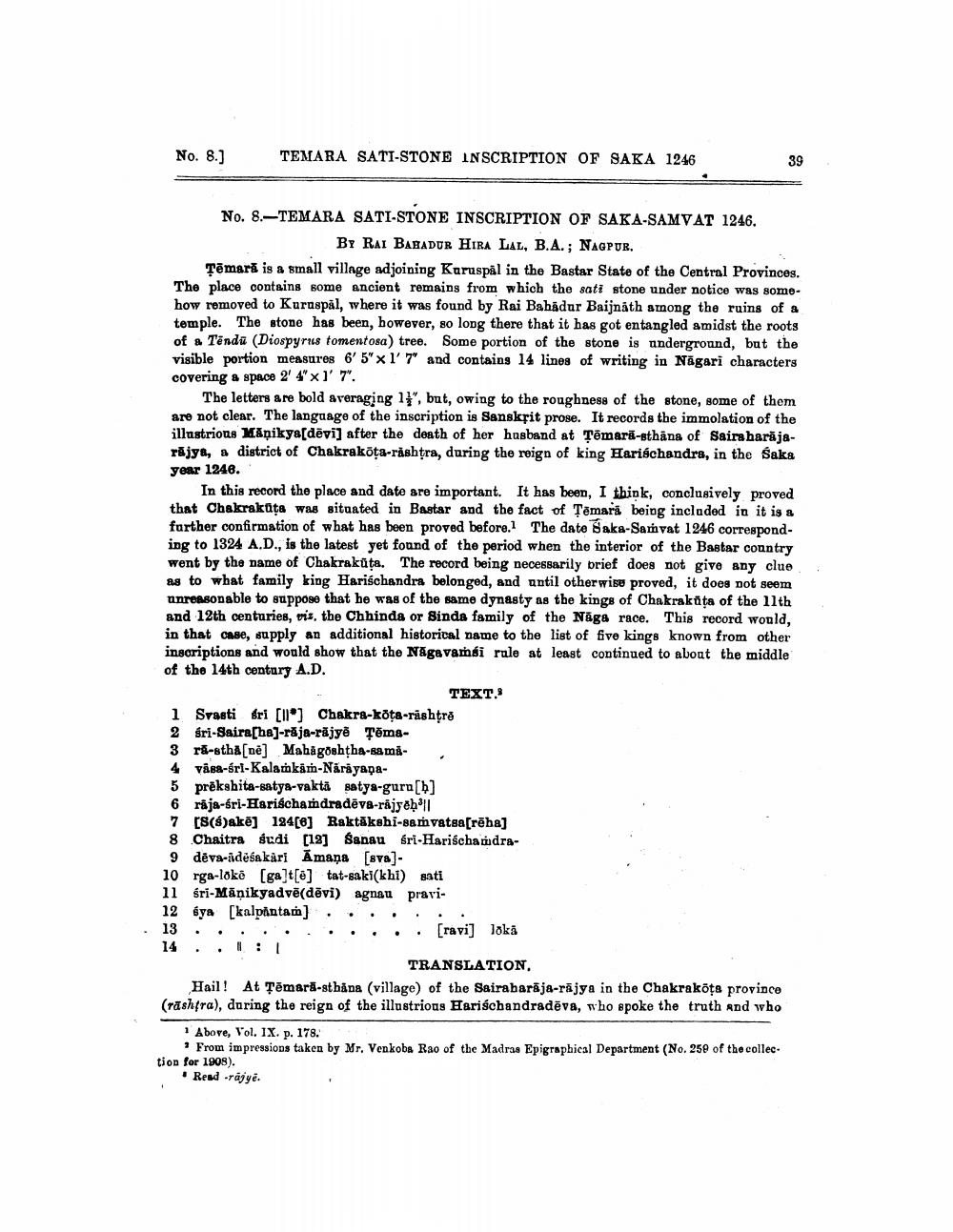________________
No. 8.)
TEMARA SATI-STONE INSCRIPTION OF SAKA 1246
39
No. 8.-TEMARA SATI-STONE INSCRIPTION OF SAKA-SAMVAT 1246.
BY RAI BAHADUR HIBA LAL, B.A.; Nagpur. Tēmari is a small village adjoining Kuruspal in the Bastar State of the Central Provinces. The place contains some ancient remains from which the sati stone under notice was somehow removed to Kuruspal, where it was found by Rai Bahadur Baijnath among the ruins of a temple. The stone has been, however, so long there that it has got entangled amidst the roots of a Tēndu (Diospyrus tomentosa) tree. Some portion of the stone is underground, but the visible portion measures 6'5" x 1'7" and contains 14 lines of writing in Nagari characters covering a space 2' 4' x1' 7".
The letters are bold averaging 1}", but, owing to the roughness of the stone, some of them are not clear. The language of the inscription is Sanskrit prose. It records the immolation of the illustrious Manikya[dēvi] after the death of her husband at Tēmarā-sthāna of Saira harājarájya, a district of Chakrakota-råshtra, during the reign of king Hariáchandra, in the Saka year 1246.
In this record the place and date are important. It has been, I think, conclusively proved that Chakrakata was situated in Bastar and the fact of Tamara being included in it is a further confirmation of what has been proved before. The date Baka-Samvat 1246 corresponding to 1324 A.D., is the latest yet found of the period when the interior of the Bastar country went by the name of Chakrakūta. The record being necessarily brief does not give any clue as to what family king Harischandra belonged, and until otherwise proved, it does not seem unreasonable to suppose that he was of the same dynasty as the kings of Chakrakata of the 11th and 12th centuries, vis, the Chhinda or Sinda family of the Näga race. This record would, in that case, supply an additional historical name to the list of five kings known from other inscriptions and would show that the NĀga varsi rale at least continued to about the middle of the 14th century A.D.
TEXT. 1 Svasti fri (11*] Chakra-kota-rashtro 2 gri-Saira[hs]-rája-răjyê Tēma3 rã-sthA[ne] Mahagoshtha-ami4 våga-srl-Kalamkam-Náriyapa5 prēkshita-satya-vakta satya-guru[b] 6 raja-sri-Harischandradēvs-rajyohl 7 [8(8)akë] 124[8] Raktákshi-samvatsa[rēha) 8 Chaitra gudi [12] Sanau sri-Harischandra9 deva-idēšakári Āmaņa (sva) - 10 rga-loke [ga]t[@] tat-saki(khi) sati 11 śri-Manikyadvē(dēvi) agnau prari12 sya [kalpintam] . . . . . . . 13 . . . . . . . . . . . [ravi] lokā 14 . . 1:
TRANSLATION. Hail! At Tēmará-stbåda (village) of the Sairabarāja-rajya in the Chakrakota province (rashtra), during the reign of the illustrious Harischandradēva, who spoke the truth and who
Above, Vol. IX. p. 178.
From impressions taken by Mr. Venkoba Rao of the Madras Epigraphical Department (No. 25of the collection for 1908).
Read .rajye.




